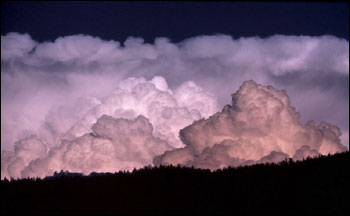

Ozone and Climate at the Surface | |||
Interactions between ozone and climate naturally occur not only in the stratosphere, but also at the Earth’s surface (troposphere). There are known chemical and physical aspects of ozone formation we can watch carefully as climate changes. Ozone forms in the troposphere by the action of sunlight on certain chemicals (photochemistry). Chemicals participating in ozone formation include two groups of compounds: nitrogen oxides (NOx) and volatile organic compounds (VOCs). In general, an increase in temperature accelerates photochemical reaction rates. Scientists find a strong correlation between higher ozone levels and warmer days. With higher temperatures, we can expect a larger number of “bad ozone” days, when exercising regularly outdoors harms the lungs. However, ozone levels do not always increase with increases in temperature, such as when the ratio of VOCs to NOx is low. As the troposphere warms on a global scale, we can expect changes in ozone air quality. Generally speaking, warming temperatures will modify some but not all of the complex chemical reactions involved in ozone production in the troposphere (such as those involving methane). Because of the short-lived nature of these chemical constituents and variations across space and time, the uncertainty is too large to make predictions. Scientists can only speculate about specific kinds of change, about the direction of change in a particular location, or about the magnitude of change in ozone amounts that they can attribute to climate. Some speculation involves VOC emissions from natural biological processes. Certain kinds of plants such as oak, citrus, cottonwood, and almost all fast-growing agriforest species emit significant quantities of VOCs. Higher temperatures of a warming climate encourage more plant growth, and therefore higher levels of VOCs in areas where VOC-emitting plants grow abundantly. Soil microbes also produce NOx. Soil microbial activity may also increase with warmer temperatures, leading to an increase in NOx emissions and a consequent increase in ozone amounts. |
|||

Another impact of climate on ozone pollution in the troposphere arises from the probability that higher temperatures will lead to greater demand for air conditioning and greater demand for electricity in summer. Most of our electric power plants emit NOx. As energy demand and production rises, we can expect amounts of NOx emissions to increase, and consequently levels of ozone pollution to rise as well. Water vapor is also involved in climate change. A warmer atmosphere holds more water vapor, and more water vapor increases the potential for greater ozone formation. But more cloud cover, especially in the morning hours, could diminish reaction rates and thus lower rates of ozone formation. Understanding the interactions between ozone and climate change, and predicting the consequences of change requires enormous computing power, reliable observations, and robust diagnostic abilities. The science community’s capabilities have evolved rapidly over the last decades, yet some fundamental mechanisms at work in the atmosphere are still not clear. The success of future research depends on an integrated strategy, with more interactions between scientists’ observations and mathematical models.
|
A warming climate can lead to more water vapor in the lower atmosphere, which would tend to produce more ozone. But cloud cover can also diminish chemical reaction rates because of reduced sunlight and therefore lower rates of ozone formation. Monitoring and analyzing such interactions is the best way we can improve our predictive capabilities. (Photograph courtesy Jeannie Allen, NASA GSFC/SSAI) | ||